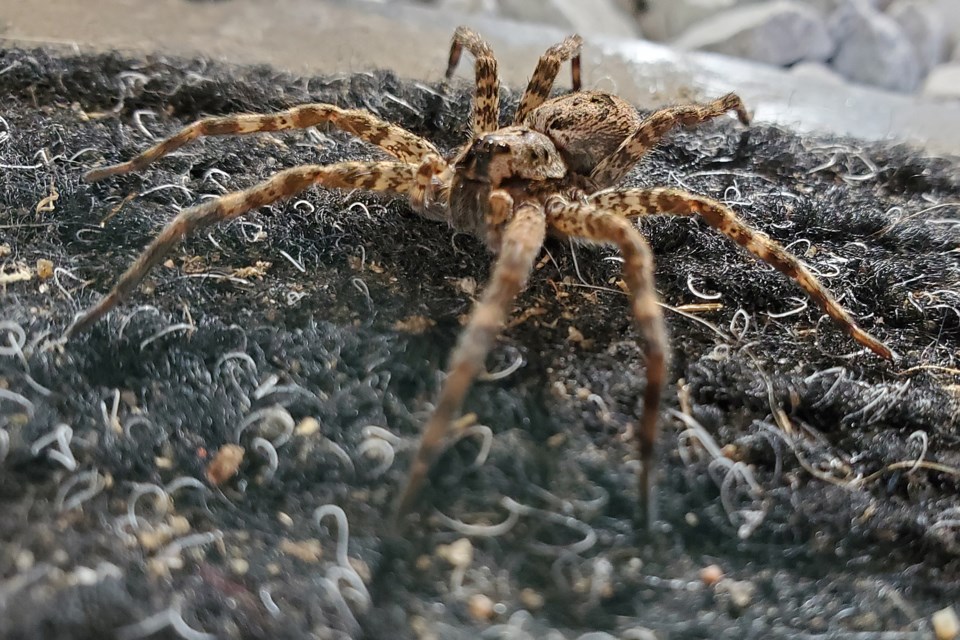As you can tell from the accompanying photograph, this week’s column is about neither cute bunnies nor cute baby chickens. However, it is about a really interesting find in our woodshed: a ginormous-sized spider.
We all know that cleaning out those long-neglected spots around the cellar and garage can often reveal some surprising discoveries, although not always the item for which you had started the search. These dark, sometimes damp, oft-undisturbed areas are a terrific sanctuary for creatures that have no desire to interact with humans.
Whether they be sow bugs and millipedes, or spiders and snakes, none like it when their perfect abode is suddenly ripped apart. “Ahh, sunlight! Arrrgh! Run for cover!” When we people come bumbling along and move the piled lumber or overturned baskets, the inhabitants get a bit startled and upset.
Spiders can be quite fascinating creatures, or the stuff of nightmares. As scientists (citizen or professional) with a natural curiosity, let’s stick with the former thought.
First, the basic stuff: Spiders are not insects. They are in a scientific group of their own. Insects have six legs; spiders and their kin have eight. Insects have three body parts (head, thorax and abdomen), whereas spiders have only two. (Perhaps some evolutionary cost cutting resulted in spiders having a blended thorax and abdomen.) Many insects have wings. Spiders never do.
The spiders of our region tend to be small to medium in size, but a vacation to a tropical regime will educate you real quickly that some of those hot tropical spiders can get quite big — nightmare-sized big. So, we are lucky, living here in a temperate weather zone. Yet another great reason for a ‘stay-at-home vacation?’
Of the thousands of species of spiders on our little plant, about 30 call Ontario home. As they are all predatory, surviving by killing other little critters, most have venomous bites. Hold on. Don’t stop reading here, as you’ll just get into that nightmare mode. Their jaws are small, maybe better described as tiny, and most couldn’t even break your skin.
One of the first steps of getting up close and personal with spiders is to determine how they obtain their prey. They all do it, just in different ways. No doubt you’ve noticed a web or two in your wanders, and this is the most common way for a spider to lasso some fast-flying food. The web may be a few strands of cobweb hung between the basement floor boards, or an intricate pattern fashioned in an artful manner between two stalks of hay.
The web strands are sticky and when Ms. Butterfly or Mssrs. Grasshopper and Moth come by for a visit, they may end up staying for lunch, whether they want to or not. Bwa-ha-ha-ha-ha! Oops, sorry, no more nightmare jokes.
Another way of getting a solid meal is that if the food doesn't come to you, you go to the food. A group of spiders known as wolf spiders (when they make the animated movie of these nature columns, I think these spiders will have a cigarette hanging loosely from their mouths and wear leather studded jackets) are masters at pursuit. No webs here to tangle up the dinner guests; these wolf spiders just run over and pick up lunch on the go.
Wolf spiders tend to be big and strong, perhaps the most physically fit of the whole spider empire. Wolf spiders — don’t mess with them, especially if you are a cricket or some other ground-crawling mini-beast.
The spider in the photo is a thin-legged wolf spider, probably a female. Like wasps and bees, the mating took place last fall followed with the imminent death of the males; the impregnated females have overwintered in protected areas and are now waking up for the brood-rearing season.
This one scurried out from under a rotting beam that I plan to replace, and once exposed to the light, it stood still. Very still. Observing. Calculating. Weighing the options. It took a tickle on its legs from my finger to convince it to keep on moving, to relocate to the other side of the shed.
Another group of spiders that run down their prey are the jumping spiders and they are without doubt the cutest little spiders you’ll ever see. That is if you ever see one, as they are indeed small and, yes, very fast, jumping huge distances to nab some unsuspecting prey. But cute. Definitely cute.
And then there’s the third way of putting food on the plate, so to speak. It may seem lazy, as no great time is spent on creating a web, nor is effort exerted in running down some hapless, pitiful, smaller creature. This method is to simply sit and wait, in ambush!
These sneaky individuals are in a group called flower spiders, or crab spiders. They hide in, on or beside a flower blossom, and wait. And hope. Hope that a bee or butterfly will come along. Hope that the flower they are sitting on will attract a pollinator. Hope that they can grab and paralyze their winged meal before it can take off again.
There are a few more groups of spiders worthy of discussion, but I shall leave them for a summertime read. For now, as you rake up last fall’s leaves and dig out whatever thing it is you have to dig out from the shed, keep your eyes open for an interesting critter or two that may have used your place as an overwintering sanctuary.
